The Rutgers University Center of Ocean Observing Leadership integrates across interdisciplinary scientific research, education and outreach and the application of an operational ocean observing system. Faculty and students comprising the scientific teams participate in collaborative research programs in which academic, industry and government partnerships are forged between physicists and biologists, between scientists and engineers, and between observationalists and modelers. The education group is the focal point for outreach activities to the K-12 community and to non-science majors within Rutgers. The Operations Center maintains a sustained coastal ocean observatory that provides real-time ocean data to the research and education groups and also serves as the training ground for Operational Oceanography students.
The COOL Operations Center
The COOL Operations Center, known as the COOL room, maintains the world’s most advanced coastal ocean observatory. State-of-the-art sampling capabilities are continuously upgraded as new technologies developed and demonstrated by the research group are immediately transitioned into the operational setting of the Center. Cost-effective sustained spatial sampling of the coastal ocean is accomplished with a variety of new platforms and sensors that include: (1) the local acquisition of satellite imagery from the international constellation of thermal infrared and ocean color sensors, (2) a triple-nested multi-static HF radar network for surface current mapping and waves, and (3) a fleet of long-duration autonomous underwater gliders equipped with physical and optical sensors, Raw datasets are shared with a variety of super-users throughout the U.S. for real-time backups, data archiving, and advanced product generation. Operational data products are produced in real time and displayed on the World Wide Web for use by scientists, educators, decision-makers and the general public. Website access peaks in the months of June, July, and August, reaching 7,000,000 hits. Visitors Log
Satellite Data
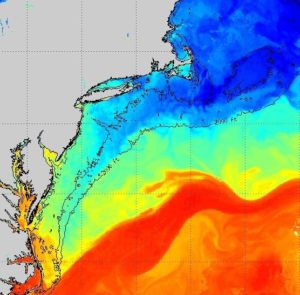
Real-time sea surface temperature data is available here.
CODAR HF Radar Network
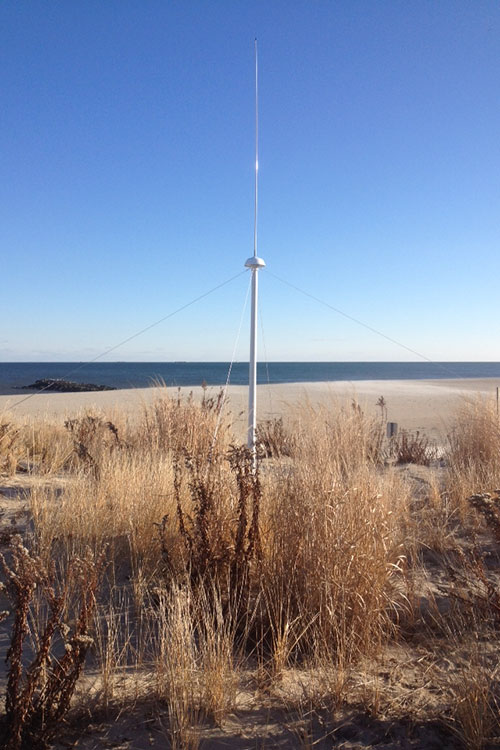 CODARs are compact HF radar systems that provide a current mapping, wave monitoring and ship tracking capability. COOL has continuously operated CODAR HF radars since 1999. COOL currently owns and operates 24 individual CODAR HF radars including a three nested multi-static network in the New York Bight and Palmer Deep Antarctica. Traditional HF radars operate in a monostatic backscatter mode, where the transmitter and receiver are collocated. Multi-static operation, enabled by GPS-based synchronization, allows a radar receiver to acquire signals from any radar transmitter within range. This transforms N individual mono-static radars into a network of N2 multi-static radars, increasing both the coverage area and the accuracy of the derived current fields. Nesting is achieved by operating at different frequencies, in our case 5 MHz, 13 MHz and 25 MHz. Higher frequencies result in higher resolution but over shorter ranges. The long range 5 MHz network is deployed from Cape May, NJ to Cape Cod, MA providing coverage of the continental shelf out beyond the shelf break and consists of 10 sites. We partner with others institutions to extend coverage down to Cape Hatteras. The intermediate 13 MHz network is along the entire New Jersey coast and consists of 7 sites. The high-resolution 25 MHz network is deployed at the entrance to and within New York Harbor and Delaware Bay – each of which has 3 sites. These sites are gps synchronized providing additional bistatic fields of component vectors.
CODARs are compact HF radar systems that provide a current mapping, wave monitoring and ship tracking capability. COOL has continuously operated CODAR HF radars since 1999. COOL currently owns and operates 24 individual CODAR HF radars including a three nested multi-static network in the New York Bight and Palmer Deep Antarctica. Traditional HF radars operate in a monostatic backscatter mode, where the transmitter and receiver are collocated. Multi-static operation, enabled by GPS-based synchronization, allows a radar receiver to acquire signals from any radar transmitter within range. This transforms N individual mono-static radars into a network of N2 multi-static radars, increasing both the coverage area and the accuracy of the derived current fields. Nesting is achieved by operating at different frequencies, in our case 5 MHz, 13 MHz and 25 MHz. Higher frequencies result in higher resolution but over shorter ranges. The long range 5 MHz network is deployed from Cape May, NJ to Cape Cod, MA providing coverage of the continental shelf out beyond the shelf break and consists of 10 sites. We partner with others institutions to extend coverage down to Cape Hatteras. The intermediate 13 MHz network is along the entire New Jersey coast and consists of 7 sites. The high-resolution 25 MHz network is deployed at the entrance to and within New York Harbor and Delaware Bay – each of which has 3 sites. These sites are gps synchronized providing additional bistatic fields of component vectors. Teledyne Webb Slocum Glider Fleet
Slocum Gliders are autonomous underwater vehicles that propel themselves through the water by changing their buoyancy and using their wings to glide in a sawtooth pattern through the water column along a subsurface transect. At user specified intervals, the glider surfaces, transmits its data to shore via the Iridium satellite system, and checks its email boxes for new directions or missions. The Slocum Gliders have been operated jointly by COOL scientists and Webb Research Corporation engineers in science experiments since 1999, transitioning to sustained deployments by the COOL Operations Center in 2003. Since then, the gliders have logged over 260,000 km of sampling in remote places such as Antarctica, Alaska, South Africa, Brazil, Sri Lanka, Norway, and in regions closer to home including the New York Bight, offshore Massachusetts, Virginia and Florida. 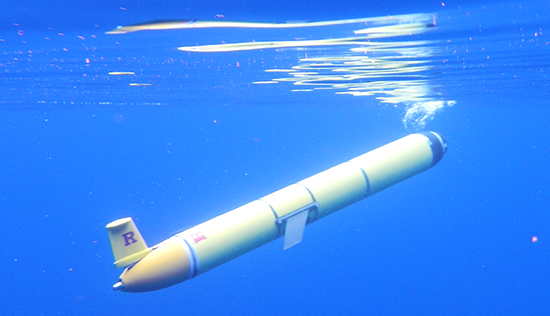 The fleet of 15 gliders now includes long duration gliders capable of several months of flight, stemming from the historic mission of RU27, the first glider to cross an ocean basin. Sensors on the gliders currently include a SeaBird CTD and a payload bay capable of carrying one of several optical sensors, including fluorometers and backscatter meters, a Beam Attenuation Meter (BAM), a hyperspectral spectrophotometer (Breve Buster), or a Fluorescence Induction and Relaxation (FIRe) sensor. Newly introduced sensors include a LISST for sediment transport measurement, pH sensor and a zooplankton acoustic sensor. A mission control center monitors glider progress on current missions and alerts operators of any problems.
The fleet of 15 gliders now includes long duration gliders capable of several months of flight, stemming from the historic mission of RU27, the first glider to cross an ocean basin. Sensors on the gliders currently include a SeaBird CTD and a payload bay capable of carrying one of several optical sensors, including fluorometers and backscatter meters, a Beam Attenuation Meter (BAM), a hyperspectral spectrophotometer (Breve Buster), or a Fluorescence Induction and Relaxation (FIRe) sensor. Newly introduced sensors include a LISST for sediment transport measurement, pH sensor and a zooplankton acoustic sensor. A mission control center monitors glider progress on current missions and alerts operators of any problems.
Computing Resources
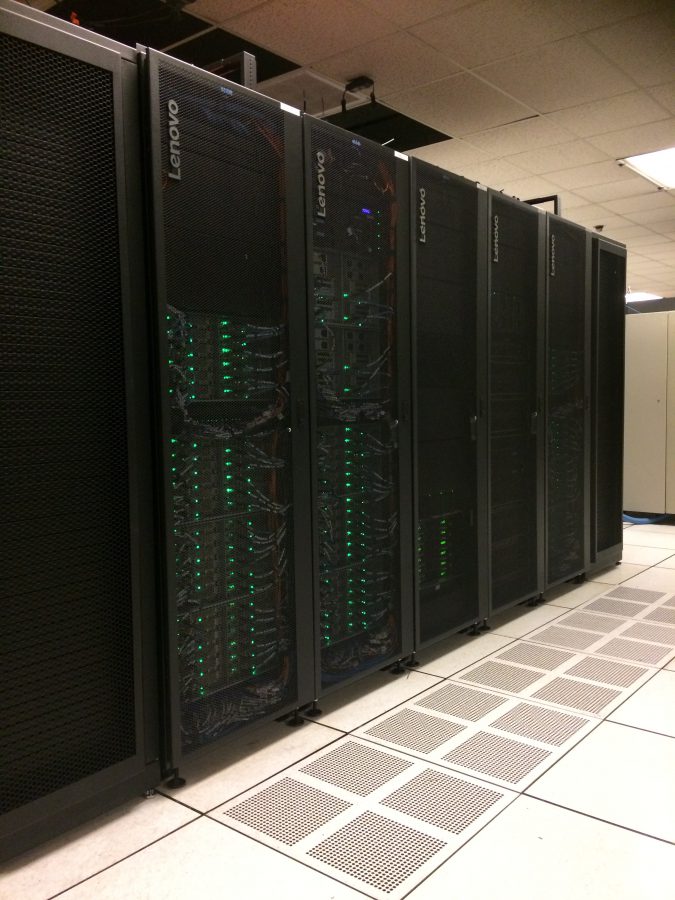 RUCOOL has access to extensive computing facilities and data distribution systems, both in-house and as part of the broader Rutgers University research computing initiative. The group owns 9 multi-core Linux compute servers for the automated acquisition, processing and visualization of near real time environmental data sets focusing on a wide range of oceanographic and atmospheric research. For research projects involving long term modeling of the ocean and atmosphere, RUCOOL owns 3 compute nodes on the in-house DMCS computing cluster, Yojo. Additionally, the group owns 2 compute nodes on Amarel, the high-performance computing cluster housed at the Rutgers University Office of Advanced Research Computing, with the ability to coordinate additional resources with other DMCS faculty to bring the total node ownership to 4 for joint research projects. Amarel is used for daily, real-time model runs of the RU-WRF mesoscale atmospheric model, in addition to modeling for various research projects.
RUCOOL has access to extensive computing facilities and data distribution systems, both in-house and as part of the broader Rutgers University research computing initiative. The group owns 9 multi-core Linux compute servers for the automated acquisition, processing and visualization of near real time environmental data sets focusing on a wide range of oceanographic and atmospheric research. For research projects involving long term modeling of the ocean and atmosphere, RUCOOL owns 3 compute nodes on the in-house DMCS computing cluster, Yojo. Additionally, the group owns 2 compute nodes on Amarel, the high-performance computing cluster housed at the Rutgers University Office of Advanced Research Computing, with the ability to coordinate additional resources with other DMCS faculty to bring the total node ownership to 4 for joint research projects. Amarel is used for daily, real-time model runs of the RU-WRF mesoscale atmospheric model, in addition to modeling for various research projects.
In addition to processing power, the lab, combined with DMCS resources, has multiple redundant and replicated web and database servers to serve data through a variety of custom interactive web applications and commonly used web data delivery services such as ERDDAP and THREDDS.
In-house systems are administered by a 3-person technical computing team and have extremely high up times (~99%). All of the data sets are stored on a local networked file-server (currently totaling 500 TB usable capacity which will soon be expanded to over 1.5PB usable) and backed up disk to disk with snapshots and disaster recovery. All in house network connectivity runs on a 10Gb/s network backbone and high-throughput (10 Gb/s) external connections to the University’s broader research computing network are also available.
Unoccupied Aircraft Systems (UAS)
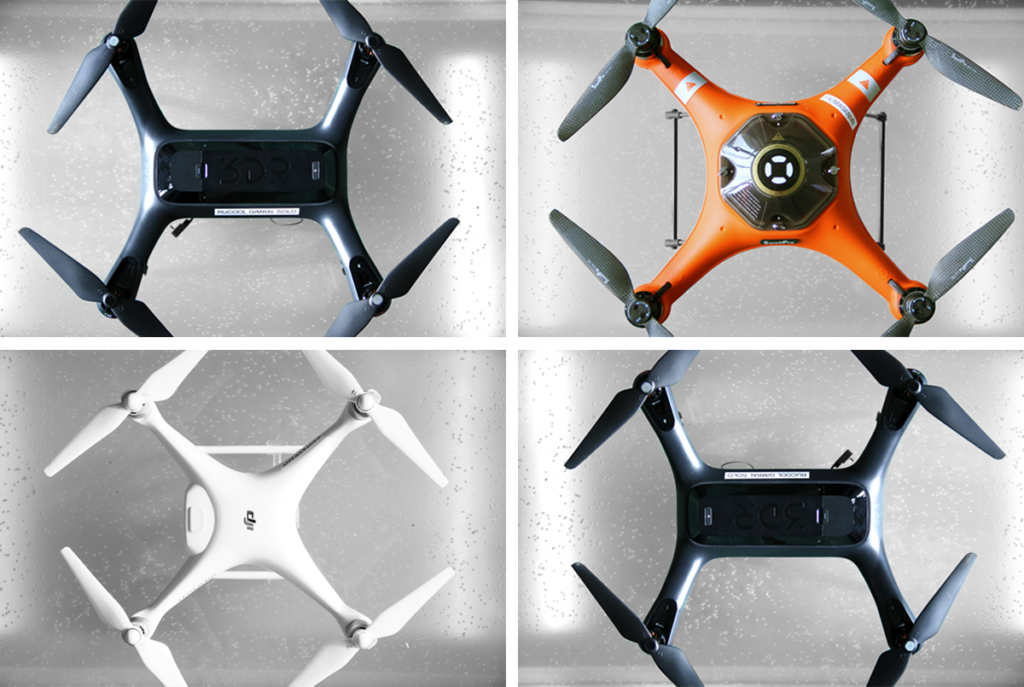 RUCOOL has recently begun utilizing Unoccupied Aircraft Systems (UAS) or drones as platforms for our research. The Center currently maintains a fleet of four vehicles for a multitude of projects. Two members of the Center hold their Remote Pilot license as certified by the Federal Aviation Administration (FAA). These platforms provide on-demand remote sensing capabilities for a number of sensors with low cost and reduced human risk to other aerial platforms.
RUCOOL has recently begun utilizing Unoccupied Aircraft Systems (UAS) or drones as platforms for our research. The Center currently maintains a fleet of four vehicles for a multitude of projects. Two members of the Center hold their Remote Pilot license as certified by the Federal Aviation Administration (FAA). These platforms provide on-demand remote sensing capabilities for a number of sensors with low cost and reduced human risk to other aerial platforms.
Laboratory Facilities
The Rutgers COOL lab shares other laboratory facilities. First, the Ecology and Physiology of Marine Organisms laboratory (Dr. Grace Saba) is designed for investigating zooplankton and fish response to environmental stressors and includes a Loligo Systems respirometry system (DAQ-M, Witrox-4 boxes, AutoResp software), metabolic chambers of various sizes, an Imaging Flow CytoBot (IFCB), SBE 55 Frame ECO Water Sampler (with 6 x 4-liter Niskin bottles), Agilent 1100 series High Performance Liquid Chromatograph system, Turner Trilogy laboratory fluorometer, Zeiss Axio inverted microscope (with Axiocam and imaging software), Zeiss Discovery V8 dissecting microscope (with camera), Zeiss Stemi 508 dissecting microscope, ring nets (various mesh sizes, filtering and non-filtering cod ends, and flowmeters), a Metrohm Alkalkinty Titrator (888 Titrando, iUnitrode pH electrodes, and accompanying software), and a Honeywell Durafet III pH electrode with UDA2182 analyzer. Additionally, we share one of the world’s largest phytoplankton analysis facilities built in collaboration with Dr. Paul Falkowski’s Environmental Biophysics and Molecular Ecology Lab for performing studies in molecular biology, biochemistry, and biophysics. The facility is shared between Drs. Falkowski and Schofield, as well as Drs. Kay D. Bidle and Maxim Gorbunov. The facility is outfitted with a full suite of microbiological supplies, several 44 sq ft. Honeywell constant temperature rooms, two mass spectrometers, two scanning UV/vis Aminco DW-2000 spectrophotometers, 3 Fast Repetition Rate Fluorometers, an SLM Luminescence UV/vis spectrofluorometer, a Coulter Multisizer, a full genomics laboratory with full sequence capability, a Pulse Amplitude Modulated Fluorometer, 3 Photosynthetrons, 1 Shimadzu High Performance Liquid Chromatograph, a Perkin Elmer C/N Analyzer, a scintillation counter, an Olympus IX71 Inverted Microscope with epifluorescence, phase contrast, differential interference contrast, and modulation contrast capabilities, an Accuri C6 benchtop flow cytometer, an InFlux Model 209S Mariner flow cytometer and high-speed cell sorter (with solid-state 355nm 60mW UV and 488nm 200mW blue lasers, a 4 way sort module, 2 scatter, 2 polarized and 4 fluorescence detectors; BD Biosciences).
Shipboard Systems and Sensors
COOL
researchers maintain an extensive array of towed platforms, winched profiling
systems, and hand-deployed profilers for shipboard sampling. Towed systems
include a 1200 kHz TRDI Workhorse ADCP mounted to a Universal Sonar Mount on
the R/V Rutgers (also available with a smaller mount system for portability), a
variety of nets for plankton sampling, and an EdgeTech 4125 sidescan sonar for
underwater imaging. Profiling sensors include standard CTDs such as the Seabird
Electronics SBE 19, an RBR Concerto, and Sontek/YSI Castaways, along with
multifunctional YSI Pro-DSS units currently configured to measure conductivity,
temperature, dissolved oxygen, and pH. Bio-optical sensors are currrently
limited to Turner and Seapoint fluorometers, as the majority of this
instrumentation has been integrated into the glider fleet for longer duration,
higher data density, and reduced cost monitoring.
